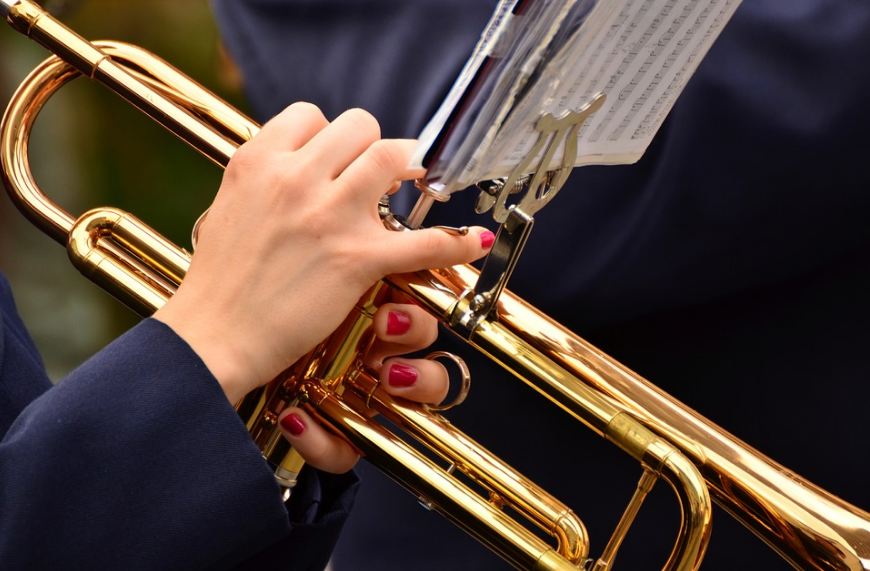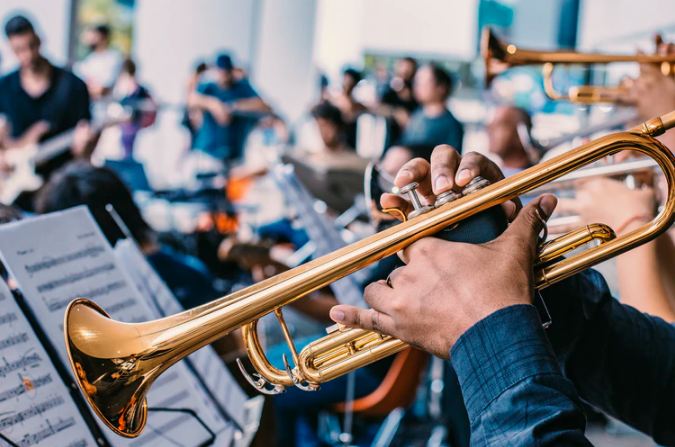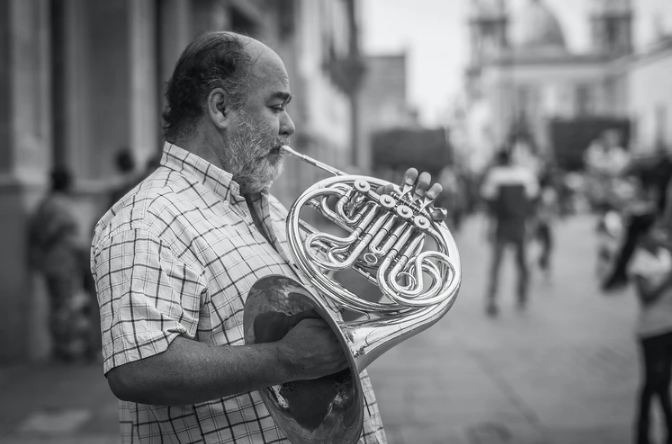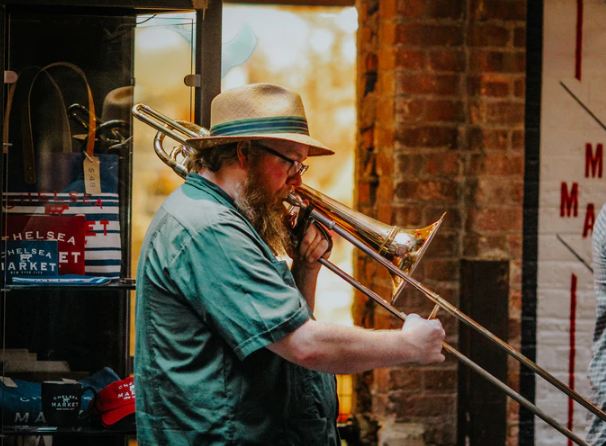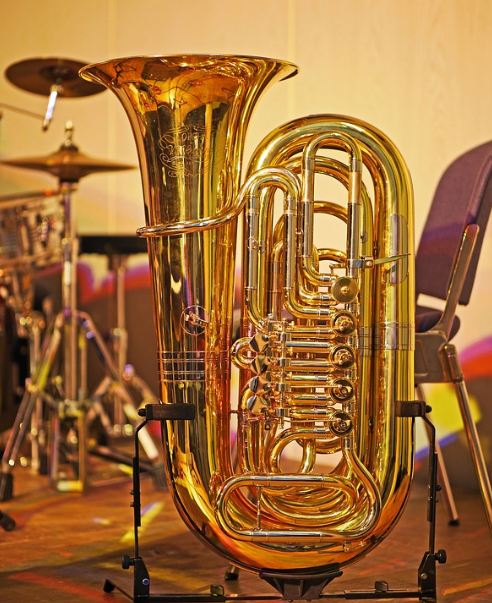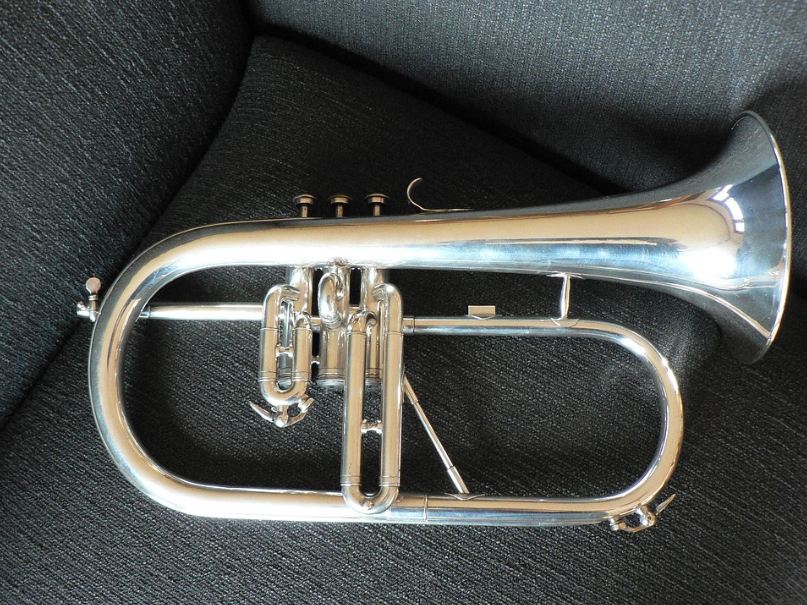Brass instruments are musical instruments that produce sound by sympathetic vibration of air in a cylindrical resonating chamber in sympathy with the vibration of the player’s lips. They are also sometimes called labrosones or labrophones, which are from Latin and Greek elements that mean “lip” and “sound.” The brass family got its name since the instruments are made of brass. In the orchestra, they play louder than any other instruments and can be heard from far away.
The early ancestors of brass instruments are made of wood, tusks, shells, and animal horns. But today, they are made entirely of brass. They are basically very long pipes that widen at their ends into a bell-like shape. Their pipes have been curved and twisted into different forms to make them easier for the player to hold and use.
Brass players use their breath to create sound, just like the woodwind family. However, instead of blowing into a reed, they vibrate their own lips by buzzing them against a metal cup-shaped mouthpiece. The mouthpiece of brass instruments helps in amplifying the buzzing of the lips, which creates the sound. If you are interested to learn more about them, read on as we’re giving you the ultimate guide to brass instruments. Also, check out bestaucasinosites australia to see the list of the best online casinos in Australia.
Brass Instruments Families
Modern brass families usually come from one of two families, which are valved brass instruments and slide brass instruments.
Valved Brass Instruments
Brass instruments that belong in this family use a set of valves operated by the player’s fingers. This introduces additional tubing or crooks into the instrument, which changes its overall length. The valved brass instruments include all the modern brass instruments, except the trombone. The trumpet, French horn, tuba, and as well as flugelhorn all belong to this family.
Slide Brass Instruments
These instruments use a slide to alter the length of the tubing. The trombone family is the main instrument in this category. However, there are also valved trombones that are being used occasionally. The sackbut, which is the trombone family’s ancestor, as well as the folk instrument called bazooka, also belong in the slide brass instruments category.
How is Sound Produced in Brass Instruments?
Brass instruments exploit the ability of the player to choose the harmonic at which the instrument’s column of air vibrates since the player has direct control of the prime vibrator, which is the lips. Players can get a good array of notes simply by varying the tension of their lips through making the instrument about twice as long as the equivalent woodwind instrument and beginning with the second harmonic.
The majority of brass instruments are fitted with a removable mouthpiece. There are various sizes, shapes, and styles of the mouthpiece that can be used to fit different embouchures or to achieve certain tonal characteristics easily. Horns are usually fitted with a conical mouthpiece, while trombones, trumpets, and tubas are fitted with a cupped mouthpiece.
If you are wondering how brass instruments differ from woodwind instruments, it is because woodwind instruments are non-directional. Meaning, the sound produced in woodwind instruments propagates in all directions with almost equal volume. On the other hand, brass instruments are highly directional. Meaning, most of its sound travel straight outward from the bell. This makes it more challenging to record a brass instrument precisely. Brass instruments also play a major role in some performances, like in marching bands.
The Different Brass Instruments
Here are the different instruments that belong to the brass family but if you are more interested to know the best online casinos in the USA, check out bestunitedstatescasinos.
1. Trumpet
Our ancient ancestors played old trumpet-like instruments before which were made out of conch-shell, wood, animal horn, or metal. Throughout history, this musical instrument has been used to gather people together, to sound alarms, as a call to war, and as well as to add a gleam to parade music. The trumpet is also the smallest member of its family, and it plays the highest pitches, featuring a bright and vibrant sound.
The modern trumpet features a slender brass pipe with three attached valves. It is curved and bent into long loops. When stretched out, its full length would be about 6 and a half feet long. In an orchestra, there are 2 to 4 trumpets, and they play both harmony and melody, and as well as provide support to the rhythm. To play the trumpet, you hold it horizontally, buzz your lips into the mouthpiece, and press down the three valves in different combinations to change pitch.
2. French Horn
The French horn is a brass instrument that came from France. It was from the 1600s French hunting horn, and it can produce different sounds ranging from very loud to very soft. It can play harsh and blaring sounds to mellow and smooth sounds. It has 18 feet of tubing that is rolled up into a circular shape. It features a large bell at its end.
In an orchestra, there can be 2 to 8 French horns, and they play both the melody, harmony, and rhythm. To play one, you need to hold it with the bell curving downward, then buzz into the mouthpiece. Your left hand will play the three valves. You can alter the type of sound you make by the way you place your right hand in the bell.
If you’d like to learn more about this brass instrument, you can read our Guide to French Horn.
3. Trombone
Among the instruments in the brass family, the trombone is the only one that uses a slide instead of valves to change pitch. It is made of long thin brass pipes with two U-shaped pipes that are linked at opposite ends to form an “S.” One pipe slides into the other for the total length of pipe to be extended or shortened.
To play the trombone, you need to hold it horizontally and buzz into the mouthpiece. With your right hand, change the pitch by pushing or pulling the slide to one of seven various positions. In an orchestra, there are usually 3 trombones to play pitches in the same range as the bassoon and cello. Also, three trombones play harmonies together.
4. Tuba
The tuba is considered the grandfather of the brass family. It is the biggest and lowest brass instrument. It anchors the harmony for the whole orchestra due to its deep rich sound. It is a long metal tube that is curved into an oblong shape. It features a huge bell at its end. Tubas can range in size from 9 to 18 feet. The longer the tuba, the lower it sounds. The standard size for a tuba is 16 feet of tubing.
In an orchestra, there is only one tuba, and it plays harmony. To play one, you need to sit down with the instrument on your lap with the bell facing up. You will blow and buzz into the large mouthpiece while your hand presses down the valves to change the sound. To be able to make sound with the tuba, you need a lot of breath.
5. Cornet
Cornet is probably the smallest among the traditional brass instruments, but it is the most played instrument by brass musicians. This instrument has a relatively velvety, lyrical, round sound, and it harmoniously blends into the brass section. When playing high notes, the cornet reaches its natural limits. Also, for many musicians, this brass instrument is quite challenging to play due to its deeper, V-shaped cup in the mouthpiece.
If you wish to learn more about this brass instrument, you can read our Guide to the Cornet.
6. Flugelhorn
The flugelhorn is similar to the trumpet and cornet. The most significant difference is in the mouthpiece. This is because the mouthpiece of a flugelhorn has a larger inner bore, which leads to higher air consumption and air use. With the lower blowing resistance of this instrument, it can swing the sound pleasantly.
7. Alto Horn
The alto horn is not usually a brass instrument that is placed in the foreground. Instead, it is usually used as an accompanying instrument. The bell and the mouthpiece on this instrument are both directed upwards, making it easy to use while sitting down. This instrument acts as a bridge in the brass section, and it adds beautiful harmony to the composition.
You can read our Guide to Alto Horn to learn more about this instrument.
Just like woodwind instruments, brass instruments are also essential in musical performances, such as in an orchestra and as well as in marching bands. We hope this guide helped you in learning more about brass instruments.

